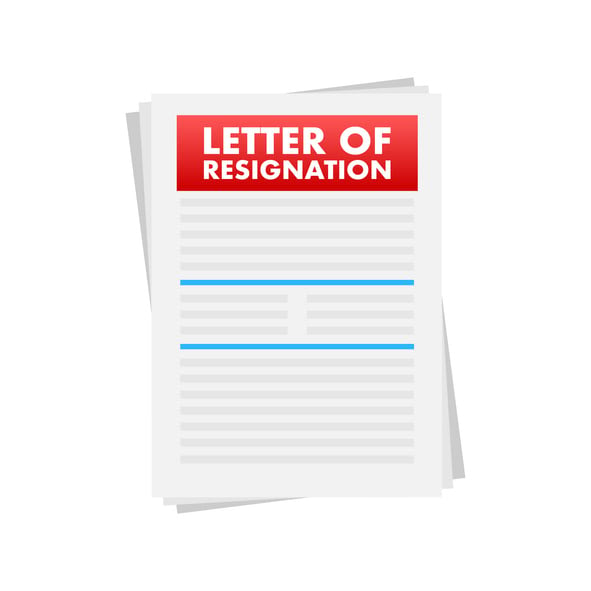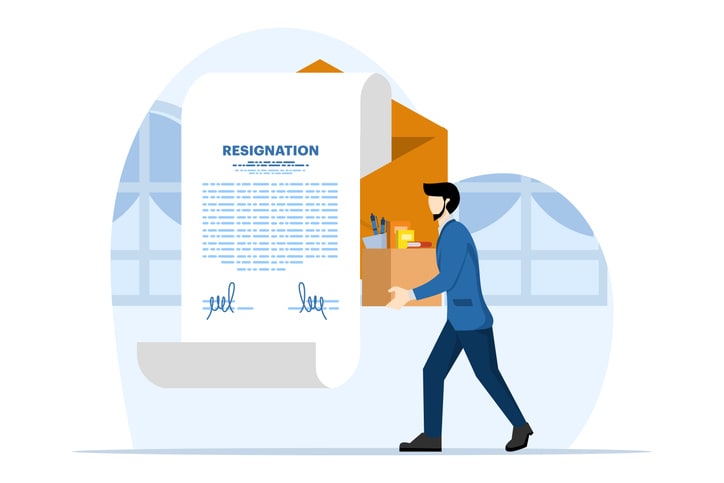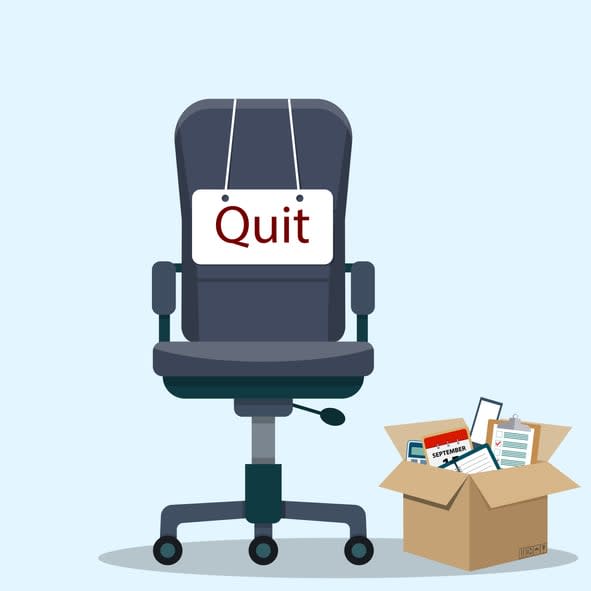Need to write a letter of resignation but not sure where to start? You’re in the right place. We’ll show you how to create a straightforward and dignified resignation letter, with essential tips, examples, and key phrases that reflect your professionalism. By the end of this article, you’ll be equipped to craft a letter that communicates your departure with grace and poise.
Key takeaways
- A resignation letter should include essential elements such as recipient identification, a clear statement of resignation, and expressions of gratitude, setting a professional tone for your exit.
- The structuring of a resignation letter is key, with a clear introductory statement of intent to resign, a body that discusses transition plans, and a conclusion that reinforces a positive and professional relationship.
- Different scenarios demand tailored resignation letters, and it’s crucial to balance honesty with professionalism, adapting the tone to fit the company culture and maintaining good relationships for future networking.
The great resignation during and after COVID saw waves of resignation letters fly around companies. And as workers spend shorter periods between new roles as part of that shake out, many more are in the pipeline. If you need to resign, as part of a remote or hybrid team, doing it well is still vital.
Essentials of a professional resignation letter

A resignation letter is not merely a formality; it’s the final chapter of your current professional story. It should be penned with the same care and attention you’ve devoted to your work. This letter is a formal document that announces your departure and sets the tone for the final days with your employer. To write a resignation letter that is both professional and polished, one must include key elements such as:
- The identification of the recipient
- Personal details
- A clear statement of resignation
- Expressions of gratitude
- A professional sign-off.
By following these guidelines, you can ensure that your resignation letter professional in tone and content.
Each component ensures the resignation process is completed with dignity and respect, paving the way for a smooth transition and preserving the professional relationship you have nurtured.
Identifying the recipient and personal details
Attention to detail begins with the basics: properly addressing your resignation letter. It’s essential to start with the current date to mark the formality of the document. Your contact information and the company’s name should be clearly stated in the header, leaving no room for confusion.
A formal salutation paves the way for a respectful tone, as addressing your manager by name and title conveys a sense of personal acknowledgment. Including your job title within the personal details further clarifies your position within the company, ensuring no ambiguity about the role you’re vacating.
Note that a resignation letter needs to be emailed or printed and handed over; email by messenger or chat application, even fun-focused companies using Kumospace, is unlikely to be accepted by human resources.
Crafting a clear and polite statement of resignation
The core of your resignation letter is the statement where you formally notify your intent to leave. Clarity is paramount; your words should leave no doubt about your decision. It’s customary to mention the last working day to provide a clear timeline for your departure, honoring the standard notice period and allowing for adequate transition planning.
Small teams without human resources might need to work out your leaving date, while high-value employees might have contract clauses that extend the usual week or four-week period to several months, depending on seniority.
While it’s tempting to delve into the reasons for leaving, such details are not obligatory and may, in fact, lead to misunderstandings if not approached with care. Instead, use unequivocal language to formally notify your employer of your resignation, focusing on the professional rather than the personal.
Expressing sincere gratitude and positive experiences
A graceful exit includes expressing gratitude for the opportunities and experiences you’ve had during your tenure. A thoughtful resignation letter should acknowledge the support and opportunities provided by the manager and the organization. Sharing a memorable experience or expressing thanks for specific opportunities can reinforce your appreciation and underscore the positive aspects of your professional journey.
Concluding your letter on a positive note with a sincere expression of gratitude will ensure you leave a positive impression, reinforcing the value of the time spent with the company.
Structuring your resignation letter

Crafting a structured resignation letter is about adhering to formalities and leaving behind an eloquent testament to your time with the company and the employment contract you’ve had during your formal resignation.
If you have advice on how the business can improve, feel free to offer it in a good-spirited way, such as improving collaboration, or improving how meetings are managed, both common issues for growing organizations.
Opening paragraph: formal notification
The opening paragraph is where you set the tone for your departure. It should begin with a formal notification that clearly states your intention to leave the company. This introductory message should be succinct, avoiding unnecessary details while focusing on the fact that you are resigning.
By stating your decision in the first few sentences of the official document, you immediately clarify the letter’s purpose, setting a clear and respectful tone for the remainder of the communication.
Body paragraph: reasons for departure and transition plans
The body of your resignation letter should include:
- Briefly touching on your reasons for leaving (optional)
- Highlighting any positive value gained from your current position
- Mentioning future opportunities that you are pursuing
- Avoiding dwelling on any negatives
This section is also where you express your commitment to a smooth transition process, specifying an exact end date and any ways you are willing to assist, such as training a replacement or creating handover documents. By initiating important transition planning and offering specific support, you demonstrate a cooperative and supportive attitude even as you prepare to leave.
Conclusion: professional sign-off and continued success wishes
The conclusion of your resignation letter is your final opportunity to leave a lasting impression. A professional sign-off is essential, as it encapsulates your overall message and leaves the reader with a sense of respect and goodwill.
Wishing the company and your colleagues continued success conveys a positive outlook and genuine desire for the organization’s prosperity even after your departure. This courteous gesture not only reflects well on you but also strengthens the professional bonds that may continue to benefit you in your career journey.
Templates for different scenarios

Not all resignations are created equal, and your departure may be driven by various circumstances, each demanding a tailored approach to the conversation. Resignation letter templates serve as versatile tools that cater to various scenarios, whether a career leap, an unforeseen personal event, or a transition to new responsibilities.
These resignation letter template foundations can help you build a personalized, situational resignation letter, ensuring that your message is appropriate and impactful.
Immediate resignation due to unforeseen circumstances
Immediate resignations are challenging due to their abrupt nature and the potential inconvenience they may cause to an employer. When unforeseen circumstances necessitate such a swift departure, it’s crucial to apologize for the suddenness and provide a brief explanation for the urgency.
While you may not be able to provide the traditional notice period, offering your support in whatever capacity possible during this brief transition period can help mitigate any negative impact.
Resigning for personal health or family reasons
When personal health or family commitments necessitate a resignation, it’s vital to emphasize the importance of these priorities. Your letter should reflect a respectful acknowledgment of the difficult nature of such decisions and an appreciation for the employer’s support during your tenure.
Be it caring for a loved one or addressing your own health, such valid reasons should be communicated with dignity and an expression of gratitude for the understanding you hope to receive.
Writing a resignation letter that maintains professional relationships

The manner in which you resign can significantly impact your professional relationships long after you’ve moved on. It’s about more than just the letter; it’s about the conversations and actions that surround your departure.
Here are some steps to take when resigning:
- Have a face-to-face discussion with your manager before submitting your resignation letter. This is a mark of professional courtesy.
- Offer your support during the transition period. This shows a level of commitment and respect.
- Follow up after submitting the letter to demonstrate your continued interest and support.
By following these steps, you can leave a lasting positive impression.
This approach preserves and can enhance your professional network, which may prove invaluable on your ongoing professional journey.
Offering support during the transition period
Your willingness to assist speaks volumes about your character during the transition period. Offering to train your replacement or help with specific tasks shows that you’re invested in the company’s continued success even as you prepare to leave. Open communication with your manager about how you can support the team during this time is a testament to your professionalism and can help ensure a seamless transition.
Even in cases of immediate resignation, demonstrating a willingness to help in any way possible can soften the blow of your sudden departure.
Handling the exit interview with careful reflection
The exit interview is an important step in the resignation process, as it allows you to share your experiences and insights with the organization. During this conversation, it’s crucial to:
- Provide honest but respectful feedback
- Focus on the positive aspects of your job
- Offer constructive suggestions for improvement
- Approach negative experiences with care and specificity to avoid leaving on a sour note.
A thoughtful exit interview that balances gratitude with insightful feedback can contribute to lasting professional respect and even lead to positive changes for those who remain.
The do's and don'ts of resignation letters

A resignation letter is a balancing act of professionalism and personal expression. It’s crucial to include positive elements such as a suggested notice period and clear communication of your resignation, which maintains a polite and respectful tone. At the same time, it’s important to steer clear of negativity, criticism, or overly detailed personal reasons for leaving, as these can detract from the professionalism of your letter and potentially harm future job prospects.
Positive elements to include in every resignation letter
In every resignation letter, it’s wise to suggest a notice period that reflects both your role and the standard expectations, providing ample time for the company to adjust to your departure. Clear communication of your resignation is key—your letter should unequivocally state your intention to leave, with a positive tone that reflects your gratitude for the time spent at the company. Including expressions of thankfulness for the opportunities you’ve had not only leaves a positive impression but also opens the door for future collaboration.
What to avoid in your resignation letter
While it’s important to be honest, using your resignation letter as a platform to vent negative emotions can backfire, damaging your professional reputation and relationships. Negative comments about the company or colleagues, regardless of your experiences, should be omitted to preserve a professional tone.
Keeping your reasons for leaving brief and free from negative emotions will ensure you part ways on amicable terms, leaving a positive lasting impression.
Leveraging resignation letter samples for inspiration

Sometimes, finding the right words to express your decision to leave can be challenging. Resignation letter examples offer a wealth of inspiration, providing the structure and wording that can be adapted to fit your personal circumstances.
Whether you’re seeking career advancement or need to resign on short notice, these examples can help you craft a letter that maintains a professional tone and respects the connections you’ve made.
Sample letter for career advancement
When resigning to pursue career advancement, it’s crucial to acknowledge the professional development and opportunities provided by your current employer. A sample letter can help you articulate your gratitude for these experiences and the positive impact they’ve had on your career path, demonstrating appreciation for the growth you’ve achieved.
Example of a short-notice resignation
Short notice resignations can be particularly challenging, as they often come about due to unexpected or urgent circumstances. A sample resignation letter for such situations should convey:
- Your awareness of the inconvenience
- Your sincere apologies
- Your commitment to providing as much support as possible during the abbreviated notice period.
Adapting your letter to company culture

Your resignation letter should mirror your time with the company, reflecting not just your personal journey but also the culture and values of the organization. Adapting your letter to the company’s culture ensures that your departure is in harmony with the environment you’ve been a part of, whether it’s the casual tone of a startup or the formality of a corporate enterprise.
Understanding the tone and formality required
The tone and formality of your resignation letter should align with the company’s communication style, which you’ve become familiar with during your tenure. This understanding allows you to craft a letter that feels authentic to the recipient, balancing professionalism with a personal touch that respects the company’s culture.
Reflecting company values in your resignation
It’s essential to weave the fabric of the company’s values into your resignation letter. This not only shows that you’ve been an attentive and involved member of the team but also allows you to express appreciation for specific experiences that embody these values.
Identifying and thanking the company for these opportunities demonstrates a deep understanding of its culture and your genuine respect.
Summary
In summary, crafting the perfect resignation letter is a strategic balance of professionalism, courtesy, and authenticity. It’s an opportunity to express sincere gratitude, clarify your intentions, and offer assistance for the transition, all while maintaining the professional relationships you’ve built. Whether you’re leaving for a new job, facing personal challenges, or seeking career advancement, a well-structured and thoughtfully written resignation letter can serve as a bridge to your future endeavors, leaving a legacy of respect and goodwill behind.
Frequently Asked Questions
Politely resign by providing a respectable reason, submitting a formal resignation letter, maintaining a positive attitude, resigning in person, giving notice, and offering to provide training for your replacement. It's important to handle the situation respectfully and professionally.
Address your resignation letter to "Dear [Company Name] Management" or "To Whom It May Concern" to ensure it reaches the relevant decision-makers. This approach will help ensure that your letter is appropriately addressed.
If you work in an all-remote company, you can use online means like Kumospace to communicate with your leaders, and direct them to an email containing your resignation letter.
It is advisable to provide a standard notice period of two weeks when resigning, although it is better to give more notice, especially for senior positions or if your employment contract specifies a different period. Consider industry norms and consult your contract to determine the appropriate notice period.
It is often preferable to print out your resignation letter and deliver it in person during a face-to-face conversation with your manager, as this is seen as a more respectful and professional approach.





